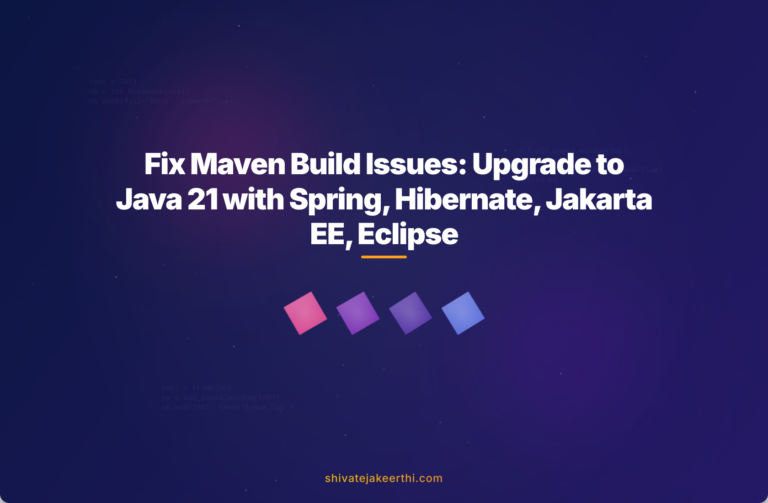Upgrading a mature Java application from Java 8 to Java 21 can significantly enhance your project’s capabilities. However, you might immediately run into an intriguing scenario: your project compiles perfectly within the Eclipse IDE showing zero errors, yet executing “mvn clean install” results in confusing build failures. If you’re scratching your head due to this mismatch, you’re not alone. This article sheds light on why this happens and offers actionable troubleshooting steps.
The issue typically surfaces when projects utilize frameworks like Spring and Hibernate, along with transitions from older Java EE code—now Jakarta EE. Maven and Eclipse can sometimes handle such upgrades differently due to separate compilers and build processes.
What Has Been Done to Cause This?
Let’s assume the following steps have recently been performed in your project:
- Upgrading from Java 8 to Java 21. Java 21 brings improvements like better performance, stability, and new language features. Making such a significant version jump means reviewing compatibility closely.
- Updating Spring and Hibernate dependencies. Framework upgrades ensure compatibility and security improvements, but each update can bring hidden complexities or deprecated functionalities requiring code modifications.
- Removal of javax dependencies for Jakarta EE migration. With Jakarta EE‘s takeover of Java Enterprise, you’ll have migrated namespaces from
javax.*tojakarta.*. If you’ve done this broadly, it’s essential to verify each dependency carefully. - Adjusting Eclipse Core Preferences. To update your IDE, you may have manually configured Eclipse to point to a JDK 21 installation, changing compiler compliance levels and updating installed build tools.
After making these notable changes, your IDE reports no obvious issue, yet running the Maven lifecycle through mvn clean install outside Eclipse throws compilation errors or unit test failures.
Eclipse Not Showing Errors—The Underlying Issue Explained
The scenario you’re encountering is pretty common during significant JDK upgrades with Maven projects managed by IDEs. But why exactly does this happen?
The reason centers around how Eclipse and Maven manage compilers and builds. Eclipse uses its internal compiler (Eclipse JDT) by default, whereas Maven typically leverages external compilation tools provided by plugins like maven-compiler-plugin. This discrepancy may cause builds in Maven to fail while Eclipse indicates everything’s fine.
For example, your Eclipse workspace may reference different compiler settings or classpaths than your Maven pom.xml explicitly defines. Even slight inconsistency can trigger a disconnect—Eclipse might silently ignore specific compilation issues, while Maven rigorously enforces compliance.
Common Errors Observed During ‘mvn clean install’
When running Maven build commands, you might encounter build logs breaking with messages like these:
[ERROR] COMPILATION ERROR :
[ERROR] /src/main/java/mypackage/ServiceClass.java:[15,35] cannot access jakarta.servlet.http.HttpServletRequest
class file for jakarta.servlet.http.HttpServletRequest not found
Or maybe you see errors like these instead:
[ERROR] Failed to execute goal org.apache.maven.plugins:maven-compiler-plugin:3.11.0:compile (default-compile) ... Compilation failure
Surprisingly though, your Eclipse IDE shows these classes and imports as resolved, highlighting no issues at all!
Troubleshooting: What Can You Do Now?
Your goal is to ensure that Eclipse correctly highlights the compilation or compliance issue to mirror Maven’s behavior. Here are actionable troubleshooting suggestions:
-
Verify Eclipse Preferences and Java Compiler Compliance Levels.
Open Eclipse, go toWindow > Preferences > Java > Compiler, and set the compliance level explicitly to Java 21. Ensure you’re targeting the exact same JDK Maven uses. -
Synchronize IDE With Maven Project Settings.
A mismatch between IDE and Maven project settings can lead to misleading feedback in your IDE. Always right-click your Eclipse project, selectMaven > Update Project..., then ensure the “Force Update of Snapshots/Releases” and “Update project configuration from pom.xml” checkboxes are enabled. -
Inspect Maven Compiler Plugin Configuration in pom.xml.
Ensure you’ve explicitly set Java 21 in the maven-compiler-plugin:<plugin> <groupId>org.apache.maven.plugins</groupId> <artifactId>maven-compiler-plugin</artifactId> <version>3.11.0</version> <configuration> <source>21</source> <target>21</target> </configuration> </plugin> -
Check Missing Dependencies Explicitly Imported in Eclipse.
Eclipse might automatically resolve certain dependencies from workspace reference. Maven does not have visibility outside pom.xml. Check your pom.xml carefully to see if any dependencies (especially servlet and Jakarta EE-related ones) have been accidentally omitted. Visit the Maven repository search page at Mvnrepository.com if needed.
Common Questions and How to Resolve Them
Here are answers to common questions users facing this issue often ask:
- “Why Isn’t Eclipse Showing Syntax Errors?”
Usually, because Eclipse uses its internal compiler settings independently from Maven, discrepancies can arise. Eclipse may reference cached builds, auto-resolved classpaths, or incomplete Java EE migrations which can cause discrepancies between IDE and external Maven builds.
- “How Can I Make Eclipse Properly Display Errors?”
Syncing Eclipse with Maven helps significantly. Regularly perform a “Maven update project” action (Right-click project > Maven > Update Project...), set compiler levels consistently, and be sure you’ve explicitly imported needed Jakarta EE dependencies in the pom file.
- “What Additional Configuration Is Required?”
Often projects need the Eclipse m2e plugin for tighter integration with Maven builds. Ensure Eclipse includes the latest m2e version and has all required m2e connectors installed.
Moving Forward: Need Some Extra Assistance?
Hopefully, you now have a clear picture of why your Java 21 upgrade is causing mysterious Eclipse-Maven synchronization issues. Anyone moving to newer Java versions, especially from a long-term supported version like Java 8, may experience similar hiccups.
If you still find yourself stuck, remember you’re part of a large Java ecosystem. Forums like Stack Overflow, official documentation for Spring, Hibernate, and Jakarta EE, and numerous developer communities can help further pinpoint your specific issue.
Have you experienced similar Maven and Eclipse discrepancies during upgrades? Share your experiences or questions in the comments section or reach out directly—I’m always happy to help resolve tricky upgrade puzzles!



0 Comments